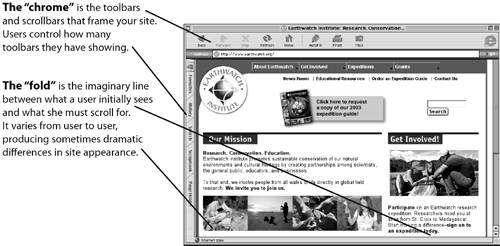designing for different systems
| Unlike print-based designs, which are distributed to everyone in exactly the same way, web sites are seen differently by different users. Your site will be viewed by users with different computers, browsers, monitors, color capabilities, and connection speeds. All of these factors affect the appearance of the site, altering its dimensions, colors, and typefaces, as well as the overall size of the browser window and the size and placement of elements within it. Design differences arise from:
platform People use the web on just about every computer (and every operating system) ever made, including Windows, Mac, and Unix. Colors may appear differently on different platforms, and different fonts may be available. Also, platform sometimes affects font size; text often appears larger on Windows than it does on the Mac. browser Users view the web through many different versions of many different web browsers, and different browsers support different design features. Inconsistent support for stylesheets is the biggest problem today; it varies even between different builds of the same browser. plug-ins Not everyone has plug-in technologies, like Flash, installed properly. So if your site uses plug-ins, not everyone will be able to see it. Because of installation problems, it's hard to estimate how many people you're excluding. See understanding flash, p. 166. monitor People use monitors of different sizes and resolutions, and this dictates how much space you get on their screens. See where's the fold? p. 91. color capability There are slight differences in color on different platforms. And older computer systems don't display the full range of colors. See color on the web, p. 146. Your challenge is to design a site that functions across the board. It doesn't have to look the same in every browser it doesn't even have to look good in every browser but it should work. 6 steps to cross-platform design:
|
EAN: 2147483647
Pages: 195
- Step 1.1 Install OpenSSH to Replace the Remote Access Protocols with Encrypted Versions
- Step 3.1 Use PuTTY as a Graphical Replacement for telnet and rlogin
- Step 5.1 General Troubleshooting
- Step 5.2 Troubleshooting Common OpenSSH Errors/Problems
- Step 6.2 Using Port Forwarding Within PuTTY to Read Your E-mail Securely
- An Emerging Strategy for E-Business IT Governance
- Linking the IT Balanced Scorecard to the Business Objectives at a Major Canadian Financial Group
- Measuring and Managing E-Business Initiatives Through the Balanced Scorecard
- Technical Issues Related to IT Governance Tactics: Product Metrics, Measurements and Process Control
- Governance Structures for IT in the Health Care Industry
